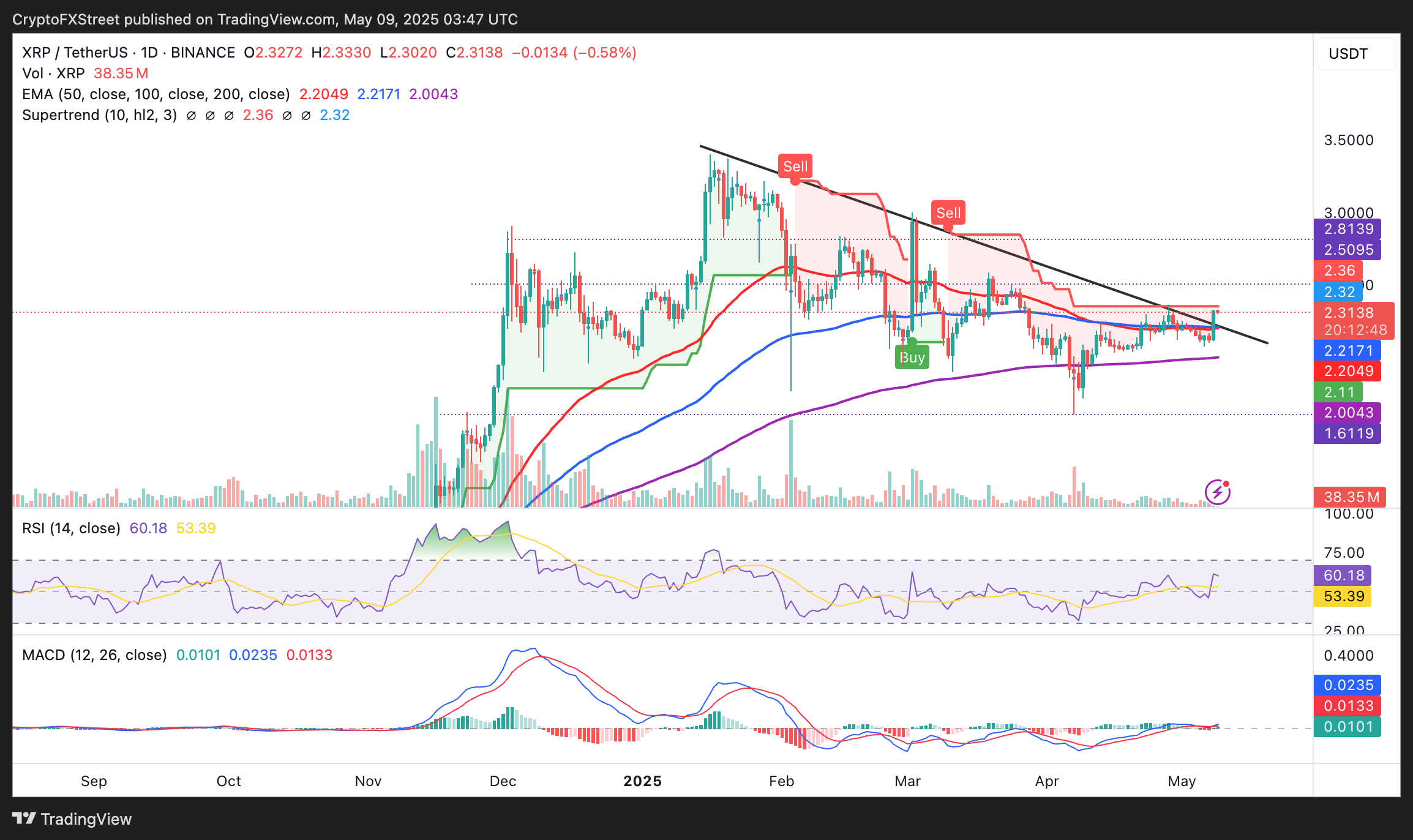Ripple Price Forecast: $3 XRP breakout looms after $50M SEC settlement
- Ripple and the SEC strike a $50 million settlement agreement pending judicial approval.
- A joint motion in the US District Court aims to lift Ripple’s injunction and release $125M in escrowed penalties.
- XRP’s price holds steady at around $2.31, setting the stage for a much-awaited breakout at $3.
Ripple (XRP) price consolidates gains around $2.31 at the time of writing on Friday, down slightly on the day. A joint motion filed by Ripple and the Securities and Exchange Commission (SEC) on Thursday revealed that the two parties have reached a settlement agreement pending judicial approval.
Meanwhile, XRP’s performance in the last 24 hours reflects a wider bullish wave in the cryptocurrency market, which saw Bitcoin (BTC) cross above $100,000 for the first time since early February.
Altcoins are rallying in unison with Bitcoin, indicating a broader risk-on sentiment after the United States (US) and the United Kingdom (UK) inked a limited bilateral trade agreement.
The agreement leaves President Donald Trump’s 10% tariff on British goods in place, fairly expands agricultural access for both nations, while reducing strict duties on British car exports.
Crypto investors embraced the trade agreement, which could set a precedent for dozens of deals President Trump is expected to negotiate within the 90-day tariff delay window.
Ripple and SEC ink $50 million settlement agreement
Ripple and the SEC filed a joint motion in the US District Court for the Southern District of New York, signaling a settlement. According to the filing, both parties have agreed to settle the lawsuit, with Ripple required to pay $50 million in penalties. Additionally, the SEC and Ripple have requested an indicative ruling to lift the injunction on Ripple and release $125 million in escrowed penalties. Ripple will pay $50 million to the SEC, with the rest returned to the company.
Judge Analisa Torres of the Southern District of New York imposed the $125 million penalty on Ripple for selling XRP to institutional investors, a fraction of the colossal $2 billion fine initially requested by the SEC.
Judge Torres also ruled that Ripple had not violated securities laws by listing XRP on exchanges for investors to buy on the open market. The SEC appealed Torres’ ruling, with Ripple filing a cross-appeal. Both parties agreed to drop their cases, setting the stage for the final end of the lawsuit filed in December 2020.
The settlement comes amid a raft of changes at the SEC, which has significantly scaled down crypto-focused investigations and litigations. President Trump’s nominee, crypto-friendly Paul Atkins, was sworn in as the SEC Chair in April.
Atkins promised to provide a firm regulatory foundation for digital assets, which removes uncertainty while fostering innovation. During the SEC’s Crypto Task Force roundtable in April, the Chair acknowledged that innovation in the crypto industry has been stifled for many years.
XRP’s uptrend gains momentum for a potential breakout
XRP’s price prepares for a major breakout as the uptrend thaws despite the SuperTrend indicator’s sell-side challenges. Flipping this indicator below the price could significantly change market dynamics, indicating a change of guard from the bears to the bulls. A buy signal is confirmed with the SuperTrend indicator shifting below XRP’s price, thus changing the colour from red to green.
The Moving Average Convergence Divergence (MACD) indicator supports the short-term bullish outlook after crossing above the centre line. A buy signal was confirmed with the MACD line (blue) crossing above the signal line. Further confirmation could follow as the green histograms expand.
Similarly, the Relative Strength Index (RSI) indicator at 61.01 backs the bullish momentum. Continued movement towards the overbought would mean a strong tailwind, propping the XRP price for an extended rally toward the $3.00 level.

XRP/USDT daily chart
Alongside the SuperTrend indicator curbing XRP’s uptrend, the RSI climbing above 70 into overbought territory might spark challenges, potentially triggering a reversal. Traders should be ready for any scenario, including a drop to the $2.21 support, where the 50-day and 100-day Exponential Moving Averages (EMAs) meet. A deeper fall could target the 200-day EMA at $2.00.
SEC vs Ripple lawsuit FAQs
It depends on the transaction, according to a court ruling released on July 14, 2023: For institutional investors or over-the-counter sales, XRP is a security. For retail investors who bought the token via programmatic sales on exchanges, on-demand liquidity services and other platforms, XRP is not a security.
The United States Securities & Exchange Commission (SEC) accused Ripple and its executives of raising more than $1.3 billion through an unregistered asset offering of the XRP token. While the judge ruled that programmatic sales aren’t considered securities, sales of XRP tokens to institutional investors are indeed investment contracts. In this last case, Ripple did breach the US securities law and had to pay a $125 million civil fine.
The ruling offers a partial win for both Ripple and the SEC, depending on what one looks at. Ripple gets a big win over the fact that programmatic sales aren’t considered securities, and this could bode well for the broader crypto sector as most of the assets eyed by the SEC’s crackdown are handled by decentralized entities that sold their tokens mostly to retail investors via exchange platforms, experts say. Still, the ruling doesn’t help much to answer the key question of what makes a digital asset a security, so it isn’t clear yet if this lawsuit will set precedent for other open cases that affect dozens of digital assets. Topics such as which is the right degree of decentralization to avoid the “security” label or where to draw the line between institutional and programmatic sales persist.
The SEC has stepped up its enforcement actions toward the blockchain and digital assets industry, filing charges against platforms such as Coinbase or Binance for allegedly violating the US Securities law. The SEC claims that the majority of crypto assets are securities and thus subject to strict regulation. While defendants can use parts of Ripple’s ruling in their favor, the SEC can also find reasons in it to keep its current strategy of regulation by enforcement.

